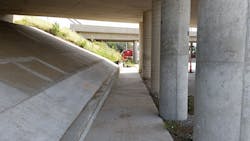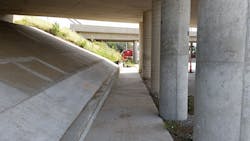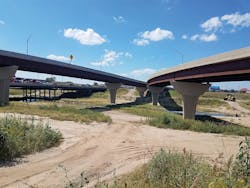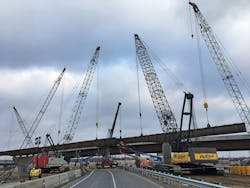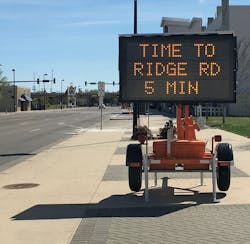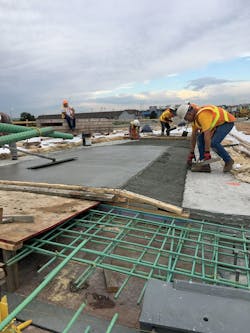Up to the challenge
When the Kansas Department of Transportation (KDOT) first began working on the redesign of the I-235/U.S. 54 interchange in Wichita, the challenge was clear—improve traffic flow and driver safety at each roadway entrance and exit on one of the most heavily traveled interchanges in the state.
With portions of the interchange dating back 50 years and more, the roadway seemed to be no longer capable of effectively supporting the transportation demands of the growing Wichita metro area, or the sharp increase in interstate truck traffic passing through—a total volume of more than 130,000 vehicles per day between the two road sections at the interchange. These tens of thousands of vehicles continually wrestled with conflict areas at all ramps connecting the highways. Existing weaving of traffic flows needed to be achieved in distances as short as 300 ft. In addition, the tight cloverleaf design of the highway ramps forced traffic down to speeds as low as 15 mph, causing further bottlenecks, and the steep grade of one of them—necessitating as much as a 10% climb—had become infamous in the area for sending trucks and other vehicles sliding backwards in icy winter conditions.
Through a quality-based selection process, KDOT chose TranSystems to design an effective alternative that meets current industry standards, which resulted in a four-phase, long-term solution. Looking to get the “biggest bang for the buck” and deliver demonstrable improvements to area motorists in the shortest possible timeframe, KDOT identified a multi-part, $116 million budget subset of construction efforts that effectively addressed several of the heaviest traffic movements between I-235 and U.S. 54. With major funding by the Kansas T-WORKS program and local contributions by Sedgwick County, the first phase, dubbed the Red Project, one of the largest roadway infrastructure projects in state history, was awarded to Dondlinger Construction in September 2015.
The Red Project entailed the design and construction of several flyover ramps on a previously fairly flat footprint, as well as several new concrete and steel girder bridges, repair and widening of eight other bridges, and 10 retaining walls, including a secant pile wall, which provided room for a ramp.
Multiple variables
With its size and complexity, the Red Project was notable for a number of reasons. It entailed the design and construction of several elevated flyover ramps on a previously fairly flat footprint, as well as seven new concrete and steel girder bridges, repair and widening of eight other bridges, and 10 retaining walls, including a secant pile wall, which provided room for a ramp. The project saw some 141,000 sq yd of new concrete pavement, 300,000 cu yd of earthwork and 14,423 ft of drainage pipe. Further, all new infrastructure needed to be created to minimize acquisition of new right-of-way. This was due to the fact that the interchange is close to a large mall, an industrial park, and, most famously, a drainage area known affectionately as “The Big Ditch,” a strategically located floodway that has saved Wichita many times from the encroaching waters of the Arkansas River. The team worked with the U.S. Army Corps of Engineers to ensure that no interference occurred to the floodway during or after construction.
The Red Project Smart Work Zone was designed to communicate actionable information to drivers to make informed decisions whether to divert to other routes.
Eliminating points of conflict
The goal of the Red Project was to eliminate as many conflict points impacting drivers entering or exiting I-235 or U.S. 54 as possible, and different areas called for different solutions. For example, two of the cloverleaf loop ramps were removed completely, replaced by elevated flyover ramps to eliminate the weaving/merging areas. Another loop ramp was redesigned for better geometry and also serves to significantly reduce the dangerous and time-consuming weaving/merging that occurred near exits and entrances.
The cloverleaf loop ramps in the southwest and northeast quadrants are now gone, replaced by an elevated two-lane flyover ramp between southbound I-235 and eastbound U.S. 54, and an elevated one-lane flyover ramp connecting northbound I-235 and westbound U.S. 54. These flyovers are among the longest highway bridges in the state, at 1,519 and 1,733 ft, respectively. Both are of curved steel girder construction and feature varying shoulder widths to provide excellent sight lines and optimize safety on the ramps. In addition to effectively helping to separate conflicting traffic, these flyover ramps allow traffic to safely maintain higher speeds, as opposed to the tight cloverleaf curves, which necessitated slowing down to 15-20 mph.
Of note, in order to keep the highways open during construction, the retaining wall designed for the U.S. 54 westbound exit ramp under I-235 is a secant pile wall, which necessitated higher cost and greater design and construction capabilities than mechanically stabilized earth (MSE) walls. This more complex and specialized wall eliminated the need for grading around the ramp, which would have required I-235 to be closed for several months.
The old cloverleaf ramp in the southeast quadrant, which connected eastbound U.S. 54 to northbound I-235, has been reconstructed in several vital ways. The steep grade, which caused many issues, especially in icy conditions, has been “flattened” to about half its old slope, making it much easier for vehicles to get to speed and maintain control. In addition, an auxiliary lane has been added, giving vehicles entering the highway more than a mile to merge, whereas before they had only about 300 ft of a combined merge area with another clover ramp exit.
In addition, to optimize flow and safety all around the highways, lanes were added to several adjacent bridges, including the I-235 bridges over Maple Street and the Kellogg Avenue Bridge over West Street; other auxiliary lanes were strategically added, and one braided ramp included increasing capacity within the limited footprint.
Some of these upgrades may be further addressed in future efforts beyond the Red Project—dubbed the Blue, Yellow and Green projects, respectively. However, the immediate impact of the current Red Project upgrades are already substantially improving traffic flow and safety on the interchange. The need to merge against conflicting traffic within 300 ft is substantially gone, as is the need to take sharply curved exits at low speed in-between accelerating or decelerating to/from highway speeds.
In addition to this long-term safety improvement, safety during the construction phase also was a focus, and the highlight was the team’s creative application of the Smart Work Zone concept.
KDOT identified $116 billion in construction efforts to address traffic movements between I-235 and U.S. 54.
Strategic action leads to diversion rates up to 70%
While the long-term improvements in operation and safety of the I-235/U.S. 54 interchange provided by the Red Project are all but a given, the quality operation and safety of the interchange during the construction period certainly were not. In fact, with the extent of the construction, frustration, slowdowns, fender benders and road rage could well have been expected to be the order of the day.
The team worked to minimize the negative construction period impacts on the driving public, both local commuters and service personnel using the interchange on a daily basis to get to and from the city and the outlying suburbs, as well as interstate truck and other traffic passing through the area. Strategic investments such as the aforementioned secant pile wall helped the team keep the highways open at least partially during even the most robust construction periods. However, perhaps the most dramatic impact on the efficiency of the traffic flow during construction came from the operation of the Smart Work Zone process.
Smart Work Zones are a concept championed by the Federal Highway Administration. The Red Project Smart Work Zone was designed to communicate actionable information to drivers so that they may make informed decisions at key locations whether to divert to other known routes. A well-designed Smart Work Zone not only eases traffic by logistically reducing volume on impacted roadways during peak periods, but also provides a psychological easement by giving drivers the power of choice to help overcome the feeling of helplessness and frustration so common in heavy traffic situations.
KDOT was a proponent of the concept, eager to do all that was possible to keep the vital interchange functioning as smoothly as possible during the construction period, even as they put in place infrastructure that would enable smooth and safe operation for the long term. That effort proved to be eye-opening, providing significant traffic diversion rates and, in that universal construction period metric, helping keep citizen complaints lower than anticipated.
Studies suggested that, to really keep the construction impact to a minimum, peak diversion rates would need to be as high as 40%—well above common goals of 15-20% for a typical construction zone. Studying the situation, KDOT took creative action. Realizing that nearby Maple Street was the best alternative to U.S. 54 for local commuters, they decided to temporarily re-time the traffic lights on this artery to be more friendly to commuter needs, creating an adequate diversion option, and invested in an extensive additional network of sensors, cameras, signs and other tools to augment existing equipment. The results exceeded even the team’s most optimistic goals, with diversion rates as high as 70% during certain lane closures. The team discovered that seven minutes seemed to be a “magic number”—when signs showed calculated trip estimates that were more than seven minutes over known commute times, many locals began to choose an alternate route, comfortably redistributing interchange capacity to arterial roadways and making the trip faster and safer for everyone.
All project components were substantially completed earlier than the projected four-year timeframe, with all areas fully open to traffic by early November 2018. Now, with the construction completed, the Smart Work Zone equipment has been removed. What remains, however, with the Red Project work being finalized, is an interchange that will provide a smoother and safer experience every day, for every driver, for years to come.
